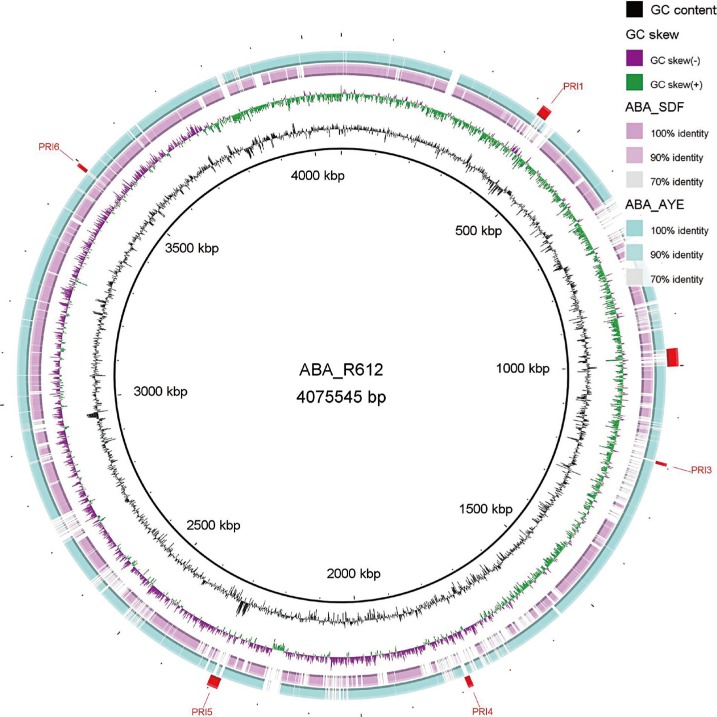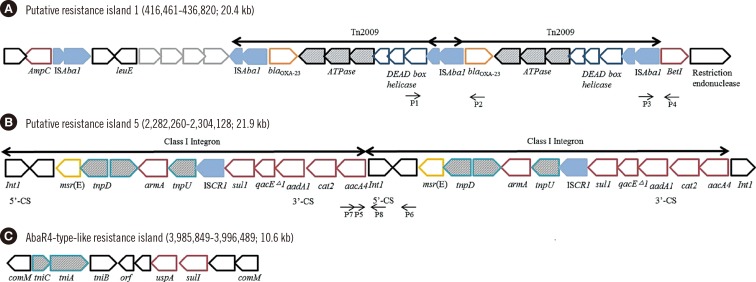Ann Lab Med.
2016 Jul;36(4):320-324. 10.3343/alm.2016.36.4.320.
Prediction of Putative Resistance Islands in a Carbapenem-Resistant Acinetobacter baumannii Global Clone 2 Clinical Isolate
- Affiliations
-
- 1Department of Laboratory Medicine, Hanyang University Seoul Hospital, Hanyang University College of Medicine, Seoul, Korea.
- 2Department of Laboratory Medicine and Research Institute of Bacterial Resistance, Yonsei University College of Medicine, Seoul, Korea. deyong@yuhs.ac
- 3Brain Korea 21 PLUS Project for Medical Science, Yonsei University College of Medicine, Seoul, Korea.
- KMID: 2373551
- DOI: http://doi.org/10.3343/alm.2016.36.4.320
Abstract
- BACKGROUND
We investigated the whole genome sequence (WGS) of a carbapenem-resistant Acinetobacter baumannii isolate belonging to the global clone 2 (GC2) and predicted resistance islands using a software tool.
METHODS
A. baumannii strain YU-R612 was isolated from the sputum of a 61-yr-old man with sepsis. The WGS of the YU-R612 strain was obtained by using the PacBio RS II Sequencing System (Pacific Biosciences Inc., USA). Antimicrobial resistance genes and resistance islands were analyzed by using ResFinder and Genomic Island Prediction software (GIPSy), respectively.
RESULTS
The YU-R612 genome consisted of a circular chromosome (ca. 4,075 kb) and two plasmids (ca. 74 kb and 5 kb). Its sequence type (ST) under the Oxford scheme was ST191, consistent with assignment to GC2. ResFinder analysis showed that YU-R612 possessed the following resistance genes: four β-lactamase genes bla(ADC-30), bla(OXA-66), bla(OXA-23), and bla(TEM-1); armA, aadA1, and aacA4 as aminoglycoside resistance-encoding genes; aac(6')Ib-cr for fluoroquinolone resistance; msr(E) for macrolide, lincosamide, and streptogramin B resistance; catB8 for phenicol resistance; and sul1 for sulfonamide resistance. By GIPSy analysis, six putative resistant islands (PRIs) were determined on the YU-R612 chromosome. Among them, PRI1 possessed two copies of Tn2009 carrying bla(OXA-23), and PRI5 carried two copies of a class I integron carrying sul1 and armA genes.
CONCLUSIONS
By prediction of resistance islands in the carbapenem-resistant A. baumannii YU-R612 GC2 strain isolated in Korea, PRIs were detected on the chromosome that possessed Tn2009 and class I integrons. The prediction of resistance islands using software tools was useful for analysis of the WGS.
MeSH Terms
-
Acinetobacter Infections/*drug therapy/microbiology
Acinetobacter baumannii/drug effects/*genetics/isolation & purification
Anti-Bacterial Agents/pharmacology/*therapeutic use
Bacterial Proteins/genetics
Carbapenems/*therapeutic use
DNA, Bacterial/chemistry/*genetics/metabolism
Drug Resistance, Bacterial
Genomic Islands/genetics
Humans
Microbial Sensitivity Tests
Multilocus Sequence Typing
Plasmids/genetics/metabolism
Polymerase Chain Reaction
Sequence Analysis, DNA
Anti-Bacterial Agents
Bacterial Proteins
Carbapenems
DNA, Bacterial
Figure
Reference
-
1. Peleg AY, Seifert H, Paterson DL. Acinetobacter baumannii: emergence of a successful pathogen. Clin Microbiol Rev. 2008; 21:538–582. PMID: 18625687.2. Lee K, Yong D, Jeong SH, Chong Y. Multidrug-resistant Acinetobacter spp.: increasingly problematic nosocomial pathogens. Yonsei Med J. 2011; 52:879–891. PMID: 22028150.3. Chung HS, Lee Y, Park ES, Lee DS, Ha EJ, Kim M, et al. Characterization of the multidrug-resistant Acinetobacter species causing a nosocomial outbreak at intensive care units in a Korean teaching hospital: suggesting the correlations with the clinical and environmental samples, including respiratory tract-related instruments. Ann Clin Microbiol. 2014; 17:29–34.4. Boucher HW, Talbot GH, Bradley JS, Edwards JE, Gilbert D, Rice LB, et al. Bad bugs, no drugs: no ESKAPE! An update from the Infectious Diseases Society of America. Clin Infect Dis. 2009; 48:1–12. PMID: 19035777.
Article5. Karageorgopoulos DE, Falagas ME. Current control and treatment of multidrug-resistant Acinetobacter baumannii infections. Lancet Infect Dis. 2008; 8:751–762. PMID: 19022191.6. Higgins PG, Dammhayn C, Hackel M, Seifert H. Global spread of carbapenem-resistant Acinetobacter baumannii. J Antimicrob Chemother. 2010; 65:233–238. PMID: 19996144.7. Perez F, Hujer AM, Hujer KM, Decker BK, Rather PN, Bonomo RA. Global challenge of multidrug-resistant Acinetobacter baumannii. Antimicrob Agents Chemother. 2007; 51:3471–3484. PMID: 17646423.8. Bellanger X, Payot S, Leblond-Bourget N, Guédon G. Conjugative and mobilizable genomic islands in bacteria: evolution and diversity. FEMS Microbiol Rev. 2014; 38:720–760. PMID: 24372381.
Article9. Soares SC, Geyik H, Ramos RT, de Sá PH, Barbosa EG, Baumbach J, et al. GIPSy: Genomic island prediction software. J Biotechnol. 2015; pii: S0168-1656(15)30115-2.
Article10. Turton JF, Baddal B, Perry C. Use of the accessory genome for characterization and typing of Acinetobacter baumannii. J Clin Microbiol. 2011; 49:1260–1266. PMID: 21289143.11. Krizova L, Dijkshoorn L, Nemec A. Diversity and evolution of AbaR genomic resistance islands in Acinetobacter baumannii strains of European clone I. Antimicrob Agents Chemother. 2011; 55:3201–3206. PMID: 21537009.12. Kim DH, Choi JY, Kim HW, Kim SH, Chung DR, Peck KR, et al. Spread of carbapenem-resistant Acinetobacter baumannii global clone 2 in Asia and AbaR-type resistance islands. Antimicrob Agents Chemother. 2013; 57:5239–5246. PMID: 23939892.13. Chen W. Comment on: AbaR4 replaces AbaR3 in a carbapenem-resistant Acinetobacter baumannii isolate belonging to global clone 1 from an Australian hospital. J Antimicrob Chemother. 2012; 67:512. author reply 513-4. PMID: 22081267.14. Hamidian M, Hall RM. AbaR4 replaces AbaR3 in a carbapenem-resistant Acinetobacter baumannii isolate belonging to global clone 1 from an Australian hospital. J Antimicrob Chemother. 2011; 66:2484–2491. PMID: 21873287.15. Kim DH, Park YK, Ko KS. Variations of AbaR4-type resistance islands in Acinetobacter baumannii isolates from South Korea. Antimicrob Agents Chemother. 2012; 56:4544–4547. PMID: 22668861.16. Nigro S, Hall RM. Distribution of the blaOXA-23-containing transposons Tn2006 and Tn2008 in Australian carbapenem-resistant Acinetobacter baumannii isolates. J Antimicrob Chemother. 2015; 70:2409–2411. PMID: 25881617.17. Zankari E, Hasman H, Cosentino S, Vestergaard M, Rasmussen S, Lund O, et al. Identification of acquired antimicrobial resistance genes. J Antimicrob Chemother. 2012; 67:2640–2644. PMID: 22782487.
Article18. McArthur AG, Waglechner N, Nizam F, Yan A, Azad MA, Baylay AJ, et al. The comprehensive antibiotic resistance database. Antimicrob Agents Chemother. 2013; 57:3348–3357. PMID: 23650175.
Article19. Lee Y, Lee J, Jeong SH, Lee J, Bae IK, Lee K. Carbapenem-non-susceptible Acinetobacter baumannii of sequence type 92 or its single-locus variants with a G428T substitution in zone 2 of the rpoB gene. J Antimicrob Chemother. 2011; 66:66–72. PMID: 21051374.20. Lee Y, Bae IK, Kim J, Jeong SH, Lee K. Dissemination of ceftazidime-resistant Acinetobacter baumannii clonal complex 92 in Korea. J Appl Microbiol. 2012; 112:1207–1211. PMID: 22404202.21. Seputiene V, Povilonis J, Suziedeliene E. Novel variants of AbaR resistance islands with a common backbone in Acinetobacter baumannii isolates of European clone II. Antimicrob Agents Chemother. 2012; 56:1969–1973. PMID: 22290980.
- Full Text Links
- Actions
-
Cited
- CITED
-
- Close
- Share
- Similar articles
-
- Carbapenem-Resistant Acinetobacter baumannii
- ISAba15 Inserted into Outer Membrane Protein Gene carO in Acinetobacter baumannii
- Dissemination of an AbaR-type Resistance Island in Multidrug-resistant Acinetobacter baumannii Global Clone 2 in Daejeon of Korea
- Update on the Epidemiology, Treatment, and Outcomes of Carbapenem-resistant Acinetobacter infections
- Antimicrobial Therapy for Infections Caused by Carbapenem-Resistant Gram-Negative Bacteria



